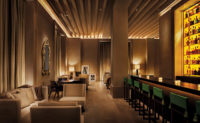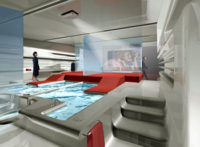Abu Dhabi, U.A.E.
When Asymptote principals Hani Rashid and Lise Anne Couture won a 2007 competition to design a 500-room luxury hotel and marina on Abu Dhabi’s Yas Island, northeast of the mainland, the directive was firm: to create an iconic complex around a Formula 1 racecourse and complete it in time to host the country’s inaugural Grand Prix on November 1, 2009. According to Rashid, “They wanted something spectacular, engaging, and powerful that would put the race and city on the world map.”
Like a mirage, the sweeping form of The Yas Hotel — part of the first phase of an ambitious master plan by developer Aldar Properties to convert the 10-square-mile desert oasis into an alluring tourist destination — evokes the speed and excitement of the event and the lifestyle it celebrates. Plus, the 914,932-square-foot project was realized in under 24 months, thanks to a skillful pragmatism comparable to that of the drivers who shared the spotlight on opening day.
Working within the time constraints of the job, the architects devised a dynamic composition incorporating the existing elliptical footprint of a previous design (halted during the early stages of construction) by juxtaposing a larger oval plan perpendicular to it. The resulting pair of glazed, 12-story, flat slab-and-column buildings are linked by an elegant “monocoque” steel-and-glass bridge and cloaked in a virtual veil of modulating light.
“It quickly became an issue to produce something to control the heat in the building,” says Rashid. So he and Couture collaborated with the BIM specialists at Gehry Technologies and Stuttgart-based engineer Schlaich Bergermann to develop the structurally independent outer skin. Comprising 5,096 lozenge-shaped, coated-and-fritted-glass panels, framed in steel, the grid shell, as it’s called, serves as a solar-shading and heat-chimney device. The 712-foot-long faceted expanse also provides a continual surface that reflects beautiful, luminous effects as the sun moves across its surface during daylight hours.
Once the designers established the idea of the grid shell, the design team saw its potential as an immense canvas on which to input data that could transfer into light sequences. “That’s when we turned to Arup Lighting,” explains Rashid.
As the architects’ main concern was to avoid a Las Vegas—style light show, they worked closely with Arup Lighting designers Brian Stacy and Richard Fisher to create a program of subtly changing, ambient light values that would not be immediately evident to onlookers and passersby. What they came up with, says Stacy, is one of the most advanced systems Arup has ever produced.
The design strategically positions close to 5,000 IP65-rated, RGBW LED luminaires at the intersections of the grid shell. These project any of seven customized video sequences onto and around the fritted-glass panels, resulting in swift 3D sequences that “fly” around the grid shell.
The lighting designers tapped U.K.-based Cooper Lighting and Safety to fabricate project-specific fixtures to meet the stringent environmental and technological demands, assuring that the light output is balanced over the various-size glass panels. At the same time, they partnered with German controls manufacturer e:cue to develop the equipment and software required to configure and monitor the sophisticated media-facade system. Features such as luminaire feedback alert the control system of problems such as overheating, in which case the LEDs can be powered down to maintain optimum operation.
“What’s beautiful about the lighting system Arup worked out for us is that we put in video feeds as opposed to color data,” notes Rashid. “The video then is parsed over 5,000 pixels running over the entire surface.”
Arup wrote the scripts and refined them to Asymptote’s specifications in New York. Prior to launch day, the designers and client tested the sequences from numerous positions around the site.
Tweaking it, says Rashid, is like working with a giant light sculpture. “The colors are muted, and there are times when it looks as if a wave has gone over the building or the building is submerged in liquid. That is quite powerful.”








Post a comment to this article
Report Abusive Comment